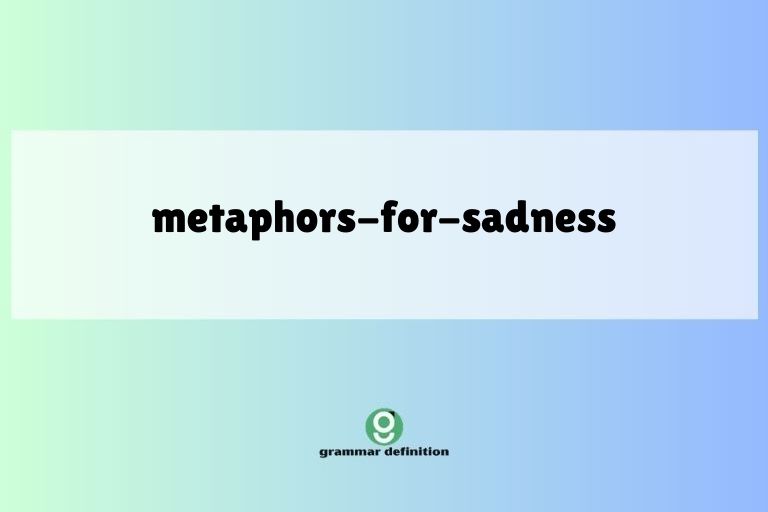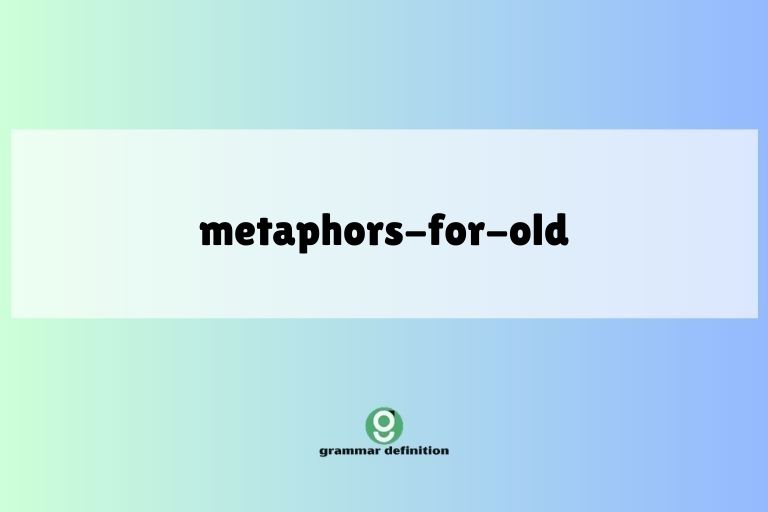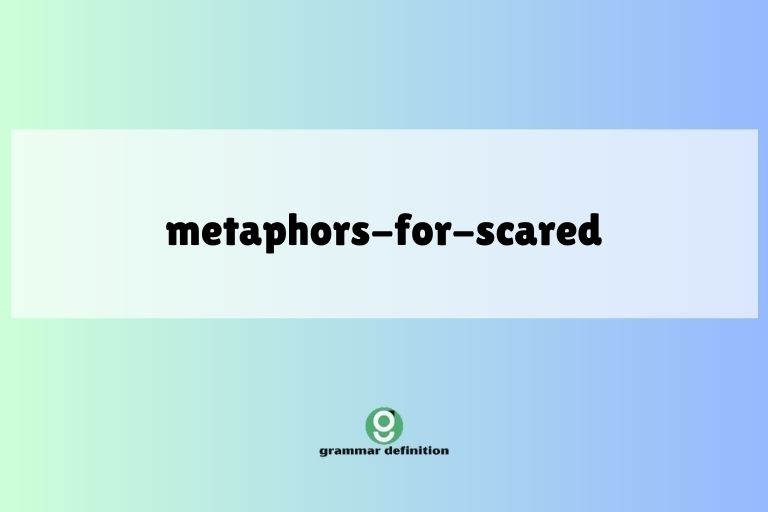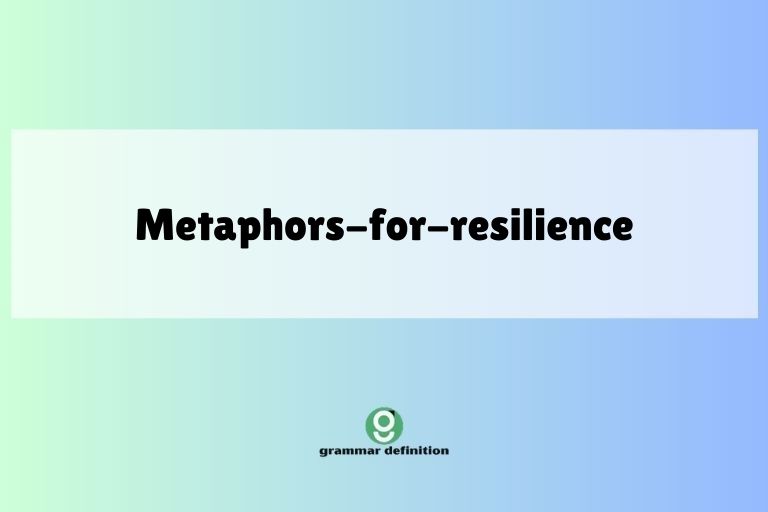Respect: Exploring Metaphors in the English Language
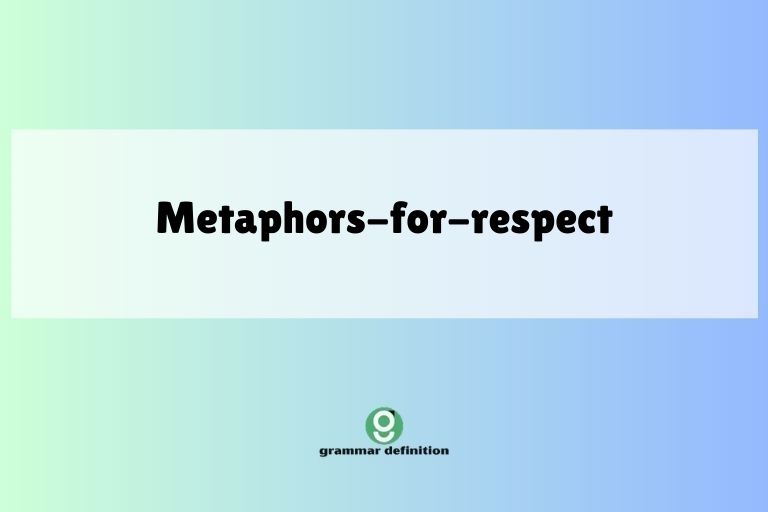
Understanding metaphors is crucial for mastering the nuances of English, as they enrich our communication and offer deeper insights into abstract concepts. This article delves into the fascinating world of metaphors for “respect,” exploring how we use figurative language to convey this vital social value.
We will examine various metaphorical expressions, their structural components, and the contexts in which they are appropriately used. This guide is designed for English language learners of all levels, from beginners seeking to expand their vocabulary to advanced speakers aiming to refine their expressive abilities.
By understanding the underlying conceptual metaphors that shape our understanding of respect, learners will be better equipped to interpret and use the English language with greater precision and cultural sensitivity. This knowledge will enhance their ability to communicate effectively, build stronger relationships, and navigate social interactions with confidence.
Whether you are a student, a professional, or simply an individual interested in language, this article provides a comprehensive exploration of metaphors for respect.
Table of Contents
- Defining Metaphors for Respect
- Structural Breakdown of Respect Metaphors
- Types and Categories of Respect Metaphors
- Examples of Respect Metaphors
- Usage Rules for Respect Metaphors
- Common Mistakes with Respect Metaphors
- Practice Exercises
- Advanced Topics in Respect Metaphors
- Frequently Asked Questions
- Conclusion
Defining Metaphors for Respect
A metaphor is a figure of speech that directly compares two unrelated things, asserting that one thing *is* the other, or implying a similarity between them. This comparison is not literal but rather symbolic, designed to create a vivid image or convey a deeper meaning.
In the context of “respect,” metaphors allow us to understand and express this abstract concept in more concrete and relatable terms. Respect, being an intangible feeling or attitude, is often described through the lens of other, more tangible experiences.
Metaphors for respect function by associating respect with something else that shares certain qualities or evokes similar emotions. For example, we might say someone “holds another in high esteem,” which metaphorically equates respect with physical elevation, suggesting that the respected person is placed on a higher level.
The classification of these metaphors falls under cognitive linguistics, where metaphors are seen as fundamental to how we think and understand the world. They operate on the principle of conceptual mapping, where one domain of experience (e.g., physical space) is used to understand another (e.g., social status).
The contexts in which respect metaphors are used are varied, ranging from everyday conversations to formal speeches and written texts. They can be found in literature, journalism, academic writing, and even casual interactions.
The choice of metaphor often depends on the specific nuance the speaker or writer wishes to convey, as well as the cultural and social context. Understanding these nuances is essential for effective communication.
Structural Breakdown of Respect Metaphors
The structure of a respect metaphor typically involves two key elements: the **source domain** and the **target domain**. The source domain is the concrete concept or image used to describe respect, while the target domain is respect itself.
For example, in the metaphor “to give someone their due,” the source domain is the act of giving something that is owed, and the target domain is showing respect.
The underlying pattern is often a simple equation: RESPECT IS [SOURCE DOMAIN]. This pattern is not always explicitly stated but is implied in the metaphorical expression.
Consider the phrase “treat someone with kid gloves.” Here, the source domain is the gentle handling associated with kid gloves, and the target domain is showing respect and care. The implied equation is: RESPECT IS GENTLE HANDLING.
The effectiveness of a respect metaphor depends on the clarity and relevance of the source domain. A good metaphor should resonate with the audience and evoke the desired emotional response.
It should also be culturally appropriate, as metaphors can have different meanings and connotations in different cultures. The structural elements also includes the linguistic devices such as verbs, nouns, and adjectives that carry metaphorical weight.
For instance, verbs like “admire,” “venerate,” and “revere” often function as metaphorical expressions of respect.
Types and Categories of Respect Metaphors
Respect metaphors can be categorized based on the underlying conceptual mappings they employ. Here are some common categories:
Respect as Elevation
This category uses the concept of physical elevation to represent respect. Higher positions are often associated with greater status and authority.
Examples include phrases like “hold someone in high regard” or “look up to someone.”
Respect as Deference
This category involves metaphors that suggest yielding or submitting to another person’s authority or wishes. Examples include “bow down to someone’s expertise” or “defer to their judgment.”
Respect as Consideration
This category focuses on the act of paying attention to and valuing another person’s thoughts, feelings, and needs. Examples include “take someone seriously” or “give someone the time of day.”
Respect as Recognition
This category uses metaphors that involve acknowledging and appreciating someone’s worth or contribution. Examples include “give credit where credit is due” or “acknowledge their efforts.”
Respect as Value
This category equates respect with assigning value or worth to someone. Examples include “treasure someone’s opinion” or “cherish their presence.”
Examples of Respect Metaphors
Below are several examples organized by the categories described above. Each table provides a variety of metaphorical expressions related to respect, illustrating the diverse ways in which we use figurative language to convey this concept.
Respect as Elevation
This table presents metaphors that use the concept of physical elevation to represent respect. The idea is that placing someone “higher” symbolizes the esteem and admiration one has for them.
| Metaphor | Explanation |
|---|---|
| Hold someone in high regard | To have a great amount of respect and admiration for someone. |
| Look up to someone | To admire and respect someone, often as a role model. |
| Put someone on a pedestal | To admire someone excessively, often unrealistically. |
| Elevate someone’s status | To raise someone’s position or standing in society or within a group. |
| Hold someone in high esteem | Similar to “high regard,” emphasizing deep respect. |
| Think highly of someone | To have a positive opinion and respect for someone. |
| Place someone above others | To consider someone superior or more deserving of respect. |
| Uplift someone | To support and encourage someone, showing respect for their potential. |
| Raise someone up | Similar to “uplift,” emphasizing support and admiration. |
| Look up to their accomplishments | To admire and respect someone’s achievements. |
| Set someone on a throne | To treat someone as if they are royalty, showing immense respect. |
| Exalt someone’s name | To praise and honor someone publicly, elevating their reputation. |
| Lift someone’s spirits | To make someone feel better, showing respect for their emotional well-being. |
| Raise a toast to someone | To honor someone with a celebratory drink, showing respect and appreciation. |
| Hold them on a higher plane | To consider them to be more intelligent, moral, or accomplished than others. |
| Put them on a high horse | To believe that someone is arrogant and condescending, suggesting they think of themselves as superior. |
| Raise them to the skies | To praise and celebrate someone excessively, almost to an unrealistic degree. |
| Elevate the conversation | To bring the level of discussion to a more serious or intelligent level, showing respect for intellectual pursuits. |
| Stand tall for someone | To support someone publicly and defend their honor, showing respect and loyalty. |
| Tower above the rest | To excel and be recognized for superior qualities, deserving of admiration and respect. |
| The pinnacle of respect | Referring to the highest point of admiration and reverence one can have for someone. |
| Reach the summit of esteem | Achieving the highest level of respect and admiration in the eyes of others. |
| Live on a higher plane | Conducting oneself with superior moral or intellectual standards, thus commanding respect. |
Respect as Deference
This table includes metaphors that use the concept of yielding or submitting to another person’s authority or wishes to represent respect. The idea is that acknowledging someone’s superior knowledge or position demonstrates respect.
| Metaphor | Explanation |
|---|---|
| Defer to their judgment | To accept someone’s opinion or decision because you respect their expertise. |
| Bow down to someone’s expertise | To acknowledge and respect someone’s superior knowledge or skill. |
| Yield to their authority | To submit to someone’s power or control, showing respect for their position. |
| Take a back seat | To allow someone else to take the lead or make decisions, showing respect for their abilities. |
| Give way to their opinion | To accept someone’s viewpoint, even if it differs from your own, showing respect for their perspective. |
| Step aside for them | To make room for someone else to take a leading role, showing respect for their potential. |
| Give them the floor | To allow someone to speak or present their ideas without interruption, showing respect for their voice. |
| Take their word as gospel | To accept someone’s statements as absolute truth, showing immense trust and respect. |
| Follow their lead | To let someone guide or direct you, showing respect for their experience. |
| Submit to their will | To accept someone’s desires or decisions, showing respect for their authority. |
| Cap in hand | Humbly seeking favor or assistance, showing deference and respect. |
| Bend the knee | To show submission and respect, often to a superior or someone in authority. |
| Humble oneself before them | To lower oneself in status or importance, showing profound respect. |
| Pay homage to their achievements | To publicly honor and show respect for someone’s accomplishments. |
| Tip one’s hat | A gesture of respect, often used to acknowledge someone’s presence or accomplishments. |
| Give them the right of way | Allowing someone precedence, showing respect for their needs or position. |
| Hold one’s tongue | Refraining from speaking out of respect for someone’s feelings or authority. |
| Abide by their decision | Accepting and following someone’s decision, showing respect for their judgment. |
| Take direction from them | Following instructions and guidance, showing respect for their expertise. |
| Surrender to their wisdom | Accepting and valuing someone’s knowledge and insight, showing deep respect. |
| Sit at their feet | Learning from someone with great humility and respect, as a student would from a teacher. |
| Give them carte blanche | Granting someone complete freedom and authority, showing immense trust and respect. |
| Do as they say | Following instructions and obeying directives, demonstrating respect for their authority. |
Respect as Consideration
This table presents metaphors that use the act of paying attention to and valuing another person’s thoughts, feelings, and needs to represent respect. The idea is that showing consideration is a form of respect.
| Metaphor | Explanation |
|---|---|
| Take someone seriously | To consider someone’s opinions and ideas with respect. |
| Give someone the time of day | To pay attention to someone and acknowledge their presence, showing basic respect. |
| Treat someone with kid gloves | To handle someone with care and sensitivity, showing respect for their feelings. |
| Walk on eggshells around someone | To be very careful not to offend someone, showing respect for their delicate emotions. |
| Hear someone out | To listen to someone’s full explanation or opinion without interruption, showing respect for their perspective. |
| Put yourself in someone’s shoes | To try to understand someone’s perspective or situation, showing empathy and respect. |
| Weigh their words carefully | To consider someone’s statements thoughtfully, showing respect for their intellect. |
| Value their input | To consider someone’s contributions as important and worthwhile, showing respect for their expertise. |
| Take their feelings into account | To consider someone’s emotions when making decisions, showing empathy and respect. |
| Think before you speak | To consider the impact of your words on others, showing respect for their feelings. |
| Mind your P’s and Q’s | To be careful and polite in your behavior and language, showing respect for social norms. |
| Hold someone’s confidence | To keep someone’s secrets or private information, showing trust and respect. |
| Give them a wide berth | To avoid getting too close to someone, either physically or emotionally, showing respect for their boundaries. |
| Tread lightly | To act cautiously and carefully, especially in sensitive situations, showing respect for others’ feelings. |
| Be mindful of their needs | To pay attention to someone’s requirements and preferences, showing care and respect. |
| Give them space | To allow someone privacy and independence, showing respect for their personal boundaries. |
| Read between the lines | To understand someone’s unspoken feelings or intentions, showing attentiveness and respect. |
| Be sensitive to their situation | To understand and respond appropriately to someone’s circumstances, showing empathy and respect. |
| Treat them with dignity | To behave in a way that acknowledges and respects someone’s inherent worth, showing fundamental respect. |
| Handle with care | To treat someone or something delicately, showing respect for their fragility or importance. |
| Protect their reputation | To defend someone’s good name and honor, demonstrating loyalty and respect. |
| Respect their boundaries | Acknowledging and honoring someone’s personal limits and needs, showing consideration and respect. |
| Value their perspective | Appreciating and considering someone’s viewpoint, showing respect for their intelligence and experience. |
Respect as Recognition
This table includes metaphors that involve acknowledging and appreciating someone’s worth or contribution to represent respect. The idea is that recognizing someone’s value is a form of respect.
| Metaphor | Explanation |
|---|---|
| Give credit where credit is due | To acknowledge someone’s contribution or achievement. |
| Acknowledge their efforts | To recognize and appreciate someone’s hard work and dedication. |
| Pay tribute to their legacy | To honor someone’s achievements and contributions, especially after they are gone. |
| Sing their praises | To publicly commend someone’s virtues or accomplishments. |
| Give them due recognition | To provide someone with the acknowledgment and appreciation they deserve. |
| Celebrate their achievements | To publicly acknowledge and honor someone’s accomplishments. |
| Hold them in reverence | To regard someone with deep respect and admiration. |
| Show them appreciation | To express gratitude and recognition for someone’s contributions. |
| Value their contribution | To consider someone’s input as important and worthwhile. |
| Recognize their talent | To acknowledge and appreciate someone’s skill or ability. |
| Give them a nod of approval | To show subtle recognition and approval of someone’s actions or ideas. |
| Raise a glass to their success | To celebrate someone’s achievements with a toast, showing respect and admiration. |
| Immortalize their name | To ensure someone’s memory and achievements are remembered for generations to come, showing profound respect. |
| Lay a wreath in their honor | To pay tribute to someone’s memory, especially those who have died in service, showing deep respect. |
| Give a standing ovation | To show enthusiastic appreciation and respect for someone’s performance or speech. |
| Mark their place in history | To acknowledge someone’s significant impact and contribution to historical events, showing lasting respect. |
| Bestow honors upon them | To formally recognize and reward someone’s achievements with awards or titles, showing public respect. |
| Pay one’s respects | To show deference and honor, especially at a funeral or memorial service, demonstrating sympathy and respect. |
| Acknowledge their presence | To recognize and greet someone, showing basic courtesy and respect. |
| Recognize their service | To acknowledge and appreciate someone’s dedication and contribution to a cause or organization, showing gratitude and respect. |
| Applaud their efforts | To express approval and admiration for someone’s hard work and dedication, showing appreciation and respect. |
| Honor their memory | To remember and celebrate someone’s life and achievements after their passing, showing lasting respect and affection. |
| Commemorate their contributions | To celebrate and remember someone’s significant contributions, ensuring their legacy is not forgotten, showing deep respect. |
Respect as Value
This table presents metaphors that equate respect with assigning value or worth to someone. The idea is that regarding someone as valuable is a form of respect.
| Metaphor | Explanation |
|---|---|
| Treasure someone’s opinion | To value someone’s viewpoint highly. |
| Cherish their presence | To appreciate someone’s company and value their existence in your life. |
| Hold them dear | To regard someone with great affection and value. |
| Prize their advice | To consider someone’s guidance as highly valuable. |
| Value their friendship | To consider someone’s companionship as important and worthwhile. |
| See the worth in them | To recognize and appreciate someone’s inherent value. |
| Consider them invaluable | To regard someone as essential and irreplaceable. |
| Esteem their character | To admire and respect someone’s moral qualities. |
| Regard them highly | To have a great amount of respect and admiration for someone. |
| See them as a gem | To consider someone as precious and valuable. |
| Hold them in high regard | To have a great amount of respect and admiration for someone. |
| Treat them like gold | To handle them with extreme care and value, as if they were precious. |
| See them as a priceless asset | To consider them extremely valuable to an organization or community. |
| Value their insights | To consider their understanding and perspectives as highly important. |
| See them as a treasure | To consider them extremely precious and valuable. |
| Consider them a gem | To see them as a rare and valuable find. |
| Worth their weight in gold | To be extremely valuable and useful. |
| Regard them as a cornerstone | To recognize them as an essential part of something larger. |
| View them as a pillar of strength | To see them as a source of support and stability. |
| Hold them in the highest esteem | To have the greatest possible respect and admiration for someone. |
| See them as a shining star | To consider them outstanding and exceptional in their field. |
| Value their loyalty | To appreciate their faithfulness and dedication. |
| See them as an icon | To regard them as a symbol of success and achievement. |
Usage Rules for Respect Metaphors
Using respect metaphors effectively requires understanding the nuances of the English language and the cultural context in which they are used. Here are some key rules to keep in mind:
- Context matters: The appropriateness of a metaphor depends on the situation and the audience. Formal settings may call for more subtle and refined metaphors, while informal settings allow for more creative and expressive language.
- Clarity is key: A good metaphor should be easily understood. Avoid using obscure or overly complex metaphors that may confuse your audience.
- Cultural sensitivity: Be aware that metaphors can have different meanings and connotations in different cultures. Avoid using metaphors that may be offensive or insensitive.
- Consistency is important: Once you establish a metaphorical framework, maintain consistency throughout your communication. Mixing metaphors can create confusion and weaken your message.
- Avoid cliches: While some common metaphors are widely understood, overuse can make your language sound unoriginal and uninspired. Try to find fresh and creative ways to express your ideas.
Furthermore, pay attention to the grammatical structure of your metaphors. Ensure that the verb tenses and sentence structure are consistent with the intended meaning.
For example, if you are using a metaphor to describe a past event, use the past tense. If you are using a metaphor to express a general truth, use the present tense.
Understanding these rules will help you use respect metaphors effectively and avoid common pitfalls.
Common Mistakes with Respect Metaphors
Even experienced English speakers sometimes make mistakes when using metaphors. Here are some common errors to avoid:
| Incorrect | Correct | Explanation |
|---|---|---|
| He holds them in low regard. | He holds them in high regard. | The correct metaphor uses “high” to indicate respect. |
| We should step on their toes. | We should treat them with kid gloves. | “Stepping on toes” implies disrespect, while “kid gloves” suggests care and respect. |
| I give him no time of day. | I give him the time of day. | The correct phrase includes “the” to indicate acknowledging someone’s presence. |
| They are underestimating their worth. | They are valuing their contribution. | “Underestimating” implies a lack of respect, while “valuing” shows appreciation. |
| She bowed up to his expertise. | She bowed down to his expertise. | “Bowing down” is the correct expression to show deference and respect. |
| He is walking on concrete around her. | He is walking on eggshells around her. | “Walking on eggshells” correctly implies being careful not to offend. |
| They take him lightly. | They take him seriously. | To “take someone seriously” signifies respect for their opinions and ideas. |
| We should ignore their input. | We should value their input. | “Valuing input” demonstrates respect for someone’s contributions. |
| She doesn’t give credit where it is taken. | She doesn’t give credit where credit is due. | The correct idiom is “credit is due,” meaning deserved. |
| He lowered them on a pedestal. | He put them on a pedestal. | The correct idiom is “put someone on a pedestal,” meaning to admire excessively. |
By being aware of these common mistakes, you can avoid misusing respect metaphors and communicate more effectively.
Practice Exercises
Test your understanding of respect metaphors with these exercises. Choose the best metaphor to complete each sentence.
Exercise 1: Fill in the Blanks
| Question | Options | Answer |
|---|---|---|
| We should always _________ our elders. | a) look down on, b) look up to, c) ignore | b) look up to |
| It’s important to _________ their feelings when making decisions. | a) disregard, b) take into account, c) dismiss | b) take into account |
| She _________ his opinion and always asks for his advice. | a) devalues, b) treasures, c) neglects | b) treasures |
| We should _________ those who have served our country. | a) disrespect, b) honor, c) disregard | b) honor |
| He always _________ to her judgment because of her experience. | a) defies, b) defers, c) ignores | b) defers |
| The community _________ his contributions to the local school. | a) undervalues, b) celebrates, c) overlooks | b) celebrates |
| It is important to _________ when discussing sensitive topics. | a) tread lightly, b) stomp heavily, c) ignore | a) tread lightly |
| They decided to _________ and listen to his point of view. | a) hear him out, b) cut him off, c) dismiss him | a) hear him out |
| We shouldn’t _________ their hard work and dedication. | a) acknowledge, b) overlook, c) appreciate | a) acknowledge |
| He _________ their friendship and considers them a valuable asset. | a) devalues, b) values, c) neglects | b) values |
Exercise 2: Correct the Metaphor
| Question | Answer |
|---|---|
| Rewrite the sentence using a respect metaphor: They do not consider his opinion important. | They do not value his opinion. |
| Rewrite the sentence using a respect metaphor: She ignores his presence when he enters the room. | She doesn’t give him the time of day. |
| Rewrite the sentence using a respect metaphor: They are very careful not to offend him. | They are walking on eggshells around him. |
| Rewrite the sentence using a respect metaphor: He doesn’t acknowledge her hard work. | He doesn’t give credit where credit is due. |
| Rewrite the sentence using a respect metaphor: They disregard his feelings when making decisions. | They don’t take his feelings into account. |
| Rewrite the sentence using a respect metaphor: The company doesn’t appreciate her contributions. | The company undervalues her contributions. |
| Rewrite the sentence using a respect metaphor: They do not admire his achievements. | They do not look up to his achievements. |
| Rewrite the sentence using a respect metaphor: She doesn’t listen to his advice. | She doesn’t prize his advice. |
| Rewrite the sentence using a respect metaphor: The community has forgotten his legacy. | The community does not pay tribute to his legacy. |
| Rewrite the sentence using a respect metaphor: They do not recognize his talent. | They do not acknowledge his talent. |
Advanced Topics in Respect Metaphors
For advanced learners, exploring the cultural and historical dimensions of respect metaphors can provide deeper insights into their meaning and usage. Different cultures may have unique ways of expressing respect, and historical events can shape the connotations of certain metaphors.
For example, the metaphor “bow down” may have different implications in a culture with a strong hierarchical structure compared to one that emphasizes egalitarianism.
Another advanced topic is the study of extended metaphors, where a single metaphorical framework is developed and elaborated throughout a text. This technique can be used to create powerful and persuasive arguments, but it requires careful planning and execution.
Analyzing the works of famous orators and writers can provide valuable examples of how to use extended metaphors effectively.
Furthermore, exploring the intersection of respect metaphors with other figures of speech, such as irony and sarcasm, can reveal subtle nuances in communication. A seemingly respectful metaphor can be used ironically to convey the opposite meaning, depending on the context and tone of voice.
Understanding these complexities is essential for mastering the art of persuasive communication.
Frequently Asked Questions
- What is the difference between a metaphor and a simile?
Both metaphors and similes are figures of speech that compare two unlike things, but they do so in different ways. A metaphor directly equates one thing with another, while a simile uses “like” or “as” to make a comparison. For example, “He is a lion” is a metaphor, while “He is as brave as a lion” is a simile.
- Why are metaphors important in language?
Metaphors enrich our language by allowing us to express abstract concepts in more concrete and relatable terms. They also add depth and nuance to our communication, making it more engaging and persuasive. Metaphors are also fundamental to how we think and understand the world.
- How can I improve my understanding of metaphors?
The best way to improve your understanding of metaphors is to read widely and pay attention to how they are used in different contexts. Analyze the source and target domains of each metaphor, and consider the underlying conceptual mapping. Practice using metaphors in your own writing and speaking.
- Are metaphors universal, or do they vary across cultures?
While some metaphors are universal, many are culture-specific. Different cultures may have different ways of conceptualizing abstract concepts, and their metaphors will reflect these differences. It is important to be aware of cultural variations when using metaphors in cross-cultural communication.
- How can I avoid misusing metaphors?
To avoid misusing metaphors, pay attention to the context in which you are using them, and ensure that they are clear and culturally appropriate. Avoid mixing metaphors or using cliches. If you are unsure about the meaning or usage of a metaphor, consult a dictionary or ask a native speaker.
- Can metaphors be offensive?
Yes, metaphors can be offensive if they are based on stereotypes or if they are used to demean or belittle someone. Be mindful of the potential impact of your words, and avoid using metaphors that may be harmful or insensitive.
- How do I identify a metaphor in a sentence?
Identify metaphors by looking for statements where something is described as being something else in a non-literal
sense. Ask yourself if the comparison is meant to be taken literally, or if it is intended to convey a deeper meaning.
Conclusion
Metaphors for respect provide a fascinating window into how we conceptualize and express this important social value. By understanding the underlying structural components, types, and usage rules of these metaphors, English language learners can enhance their communication skills and navigate social interactions with greater confidence.
As you continue your language learning journey, pay attention to the metaphors you encounter in everyday conversations, literature, and media. By doing so, you will deepen your understanding of the English language and gain valuable insights into the cultural norms and values that shape our world.


